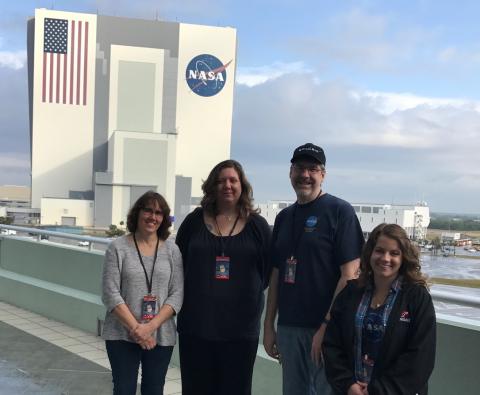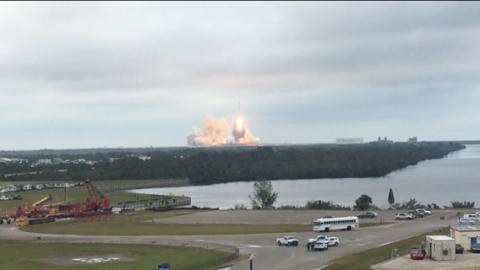SpaceX Dragon mission carrying the Lightning Imaging Sensor (LIS) to the International Space Station (ISS) was successfully launched on February 19. Four members of the GHRC DAAC team – ISS LIS project manager Will Ellett, Michele Garrett, Mary Nair and Amanda Weigel – were able to attend the launch. ISS LIS is part of the DoD STP-H5 (Space Test Program-Houston 5) payload package, which was installed on Thursday February 27, 2017 and powered on for instrument check-out early the next day.

On Saturday February 18, 2017 members of SpaceX and NASA gathered at Kennedy Space Center’s observation building to witness the first launch off the historic Apollo/Saturn V launch pad 39A since the shuttle missions ended in 2011. SpaceX attempted to launch their Falcon 9 rocket carrying the CRS-10 Dragon spacecraft into orbit on a resupply mission to the International Space Stations. Aboard the CRS-10 Dragon was the Lightning Imaging Sensor (LIS) a backup to the TRMM LIS instrument that provided scientists with over 17 years of lightning data and is planned to continue lightning observations from the ISS. In addition to the launch, SpaceX attempted its fourth vertical landing of the stage one rocket 6 miles south of pad 39A. The first launch attempt was scheduled for 10:00 AM on February 28th however, the launch was aborted 13 seconds prior to lift-off. The launch successfully occurred at the next launch window, Sunday morning, February 19th, at 9:38 AM.
From Saturday evening through Sunday morning an upper level trough brought rain and clouds through the Orlando-Titusville Florida area. Meteorologists closely monitored weather conditions in hope that both the rain and high cloud tops would move out of the area before launch that morning. It was only at 9:30 am, 8 minutes before launch, that the weather improved and the launch countdown commenced. Five seconds before launch the Falcon 9 engines ignited and at zero seconds, the rocket began to move vertically upwards and quickly disappeared in the clouds. The sonic boom and sounds of the Falcon 9 making its way to space were still audible.

Following the launch, at t-minus 9 minutes, SpaceX attempted to vertically land the detached stage one rocket that was used to push the CRS-10 Dragon into space. From the observation deck spectators could hear the dull noise of the the rocket nearing Earth's surface. Out from the clouds the rocket descended vertically and landed on the surface, releasing another sonic boom. SpaceX had successfully launched from the historic 39A pad and completed another stage one vertical land landing!
On Thursday, February 23rd CRS-10 Dragon docked at the International Space Station. In the subsequent days, the science package was unloaded and placed in position on the space station. NASA GHRC has been working alongside scientists and engineers to prepare the first images and data from LIS. The release of LIS data is expected to occur in early April 2017. Near real-time and standard lightning products from ISS LIS will be processed, archived and distributed at the GHRC DAAC for the public to explore.






